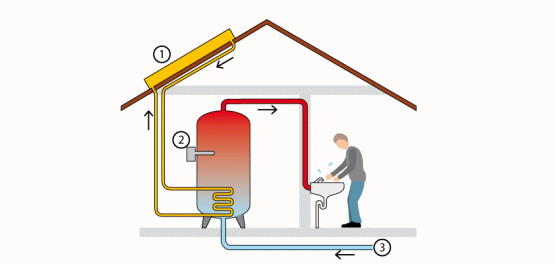Solar heat
A solar heat system can reduce the need for purchased energy by 2000–6000 kWh/year in a normal single-family house, depending on the system and the size of the solar collector.
Solar heat performs best together with a boiler. If combined with wood or pellet firing, best economy will be achieved, while also being of greatest benefit to the environment.
Solar heat can supply around half of the annual hot water requirements of a normal family. In such cases, a standardized solar heating system is used in which solar collectors with an area of 4-6 m² are connected to a hot water storage tank with a volume of 200-300 litres. Take the opportunity to invest in solar heat when changing your hot water storage tank, and the additional cost for solar heat will then be a minimum.

This is a schematic illustration of a solar collector system that supplies warm water. No. 1 Solar collector. No. 2 Electric immersion heater. No. 3 Cold water inlet. Illustration: Bo Reinerdahl
Hot water and make-up heat
Solar heat may supply most of the heating and hot water requirements during 4–6 months of the year in a normal single-family house in southern Sweden, and for a somewhat shorter period in northern Sweden. The condition is that you have a water-based heating system. Combination systems are used for this type of heating system, which normally consists of 8–12 m² of solar collectors connected to a storage tank with a volume of 500–750 litres. A combination system is adapted and rated to suit the actual heat demand and the heating boiler in your house. Take the opportunity when changing your heating boiler, and ask for assistance in its rating from your local installation contractor or a solar heat equipment supplier.
Other applications
Solar heat is the best alternative for heating a swimming pool or an outdoor bath. A solar collector can supply the whole of the heat demand and the bathing season can be extended by a few weeks without any additional cost. Solar heat is also well suited for group stations in residential areas and for small district heating systems, particularly in combination with biofuel.
Economy
Solar radiation is free of charge and would be difficult or impossible to tax. A solar heat system involves some installation costs but reduces the cost of purchased energy. The profitability of solar heat therefore increases when the interest rates are low and energy prices are on the increase. When the system has been paid for, solar heat is basically free of charge, since the operating cost is low.
P marked solar collector
Choose a solar collector that is P marked when making your investment, so that you will be sure to buy a good product. The marking is backed by the Technical Research Institute of Sweden (SP). P marking means that the solar collector undergoes regular quality inspection and guarantees that the product meets the specified requirements as regards operation, durability, etc.
Advantages and disadvantages
+ reduces your energy costs
+ improves convenience
+ allows you to play your part in conserving the environment
- expensive to install
- delivers mainly domestic hot water


